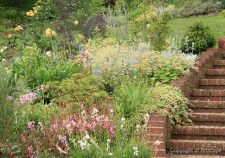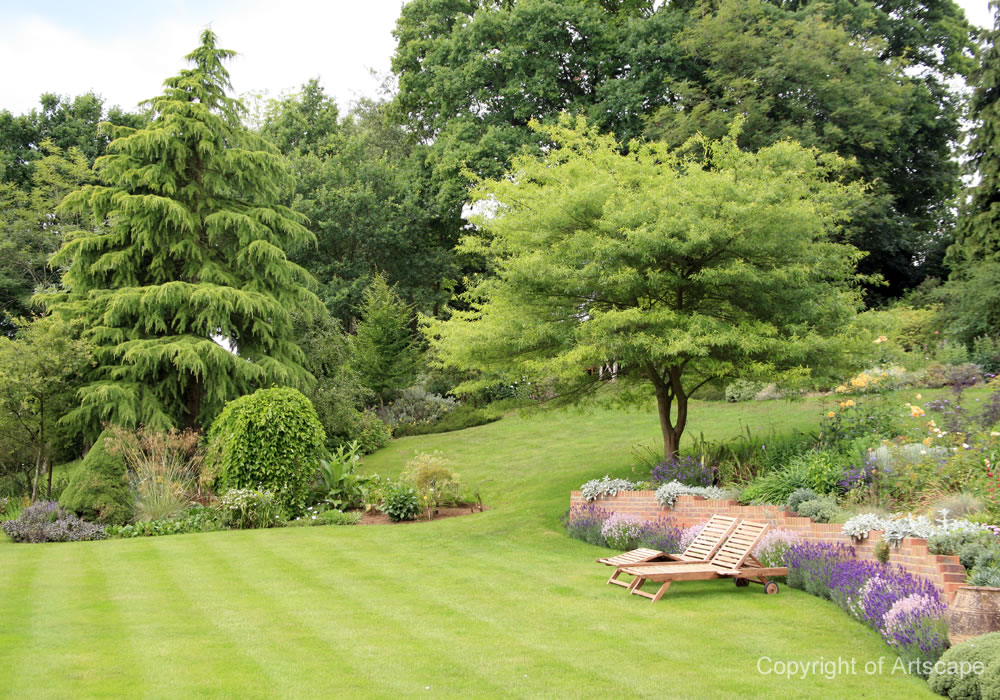Whether you have a steep bank or just a gradual incline there are many ways a sloped garden can be transformed with landscaping. Here are some ideas from Artscape to bring your sloping garden to life.
 What to consider when landscaping on a slope
What to consider when landscaping on a slope
First think about the style of garden you would like. Would you prefer a formal design with lots of structure or a more informal, natural look? A sloping garden can particularly suit a cottage-style with its lack of straight lines and precise shapes. Instead, winding pathways and an abundance of perennial flowers. Another idea might be to transform a slope with an understated Japanese-inspired landscape, with a rockery and layers of interesting texture. The style you choose will guide you in your choice of landscaping materials, such as the type, texture and colour of the stone, gravel or timber you might want to use.
The layout of a sloped garden needs to be carefully designed so every level works together to achieve a balanced, accessible, and attractive overall look.
Also consider safety. This is important as you need to ensure that areas of the garden won’t be hazardous or difficult to access. When the angle of the slope is extreme, steps will be a necessity.
Create different zones and terraces
 A long, sloping garden could be landscaped with a tiered design with a series of flat terraces creating different usable zones. A dining patio, a sun deck, a kitchen garden or a play area perhaps. Well-designed and built steps will provide the best transition between spaces in a sloping garden. For paths, steps and patios are best built in a textured, hard-wearing stone for safety in wet weather or icy conditions as this will provide more grip underfoot. Stone comes in a wide choice of colours and finishes too.
A long, sloping garden could be landscaped with a tiered design with a series of flat terraces creating different usable zones. A dining patio, a sun deck, a kitchen garden or a play area perhaps. Well-designed and built steps will provide the best transition between spaces in a sloping garden. For paths, steps and patios are best built in a textured, hard-wearing stone for safety in wet weather or icy conditions as this will provide more grip underfoot. Stone comes in a wide choice of colours and finishes too.
Clever planting
The soil conditions of a hillside garden are often less than ideal. Slopes are prone to soil drying and erosion as the topsoil tends to run off, taking the nutrients with it. So selecting plants that thrive in quick-draining soil is a good idea.
Also choose plants that will hold the ground in place and require minimal maintenance, such as shrubs and ornamental grasses. Strong growing climbers and groundcover plants will help to stabilise the soil and provide rapid coverage. It is not advisable to have a lawn that needs mowing on a steep slope. However, if you long for a grassy bank, you could consider having a wildflower meadow.
 Consider planting for an exposed slope, as you might want to create a living windbreak of trees and shrubs to reduce the effects of strong winds. This will have the additional benefits of reducing moisture loss from the soil, supporting wildlife and providing soundproofing from traffic noise.
Consider planting for an exposed slope, as you might want to create a living windbreak of trees and shrubs to reduce the effects of strong winds. This will have the additional benefits of reducing moisture loss from the soil, supporting wildlife and providing soundproofing from traffic noise.
Retaining walls would add structure to the space and keep each level in place, while also providing raised flower beds.
Planting for privacy
If your sloping garden is overlooked by a lower property, you will want to introduce some screening. The gradient means you can plant taller trees and shrubs on lower levels to effectively screen the upper area used for seating or dining. Ideally choose mature trees and shrubs for instant screening. Clever planting will block the view from a neighbouring property, while retaining your own views and without casting unwanted shade.
Install railings
When an outdoor space isn’t flat or level, the risk of falls is heightened. Consider installing handrails at points along a steep garden path or steps. They can be ornate in design, rustic or minimalist in metal depending on your garden scheme.
 Add water features
Add water features
Water features bring a sense of tranquillity to a garden. An incline provides different opportunities to introduce water, such as a flowing waterfall with the sound of gently trickling water. The effect could be classically elegant and formal or be designed to look more rugged and natural.
Lighting for ambience and safety
Garden lighting can add a romantic atmosphere or drama to the scheme, highlighting specimen plants, artworks and water features. A mix of ambient and functional outdoor lighting is ideal. Steps and pathways should always have good lighting built in, even at a low level, to avoid the risk of slipping.
Invest in the best landscaping for your sloped garden
Please do get in touch with us to discuss how Artscape’s award-winning garden design and landscaping service could transform your sloped garden and add value to your home.





